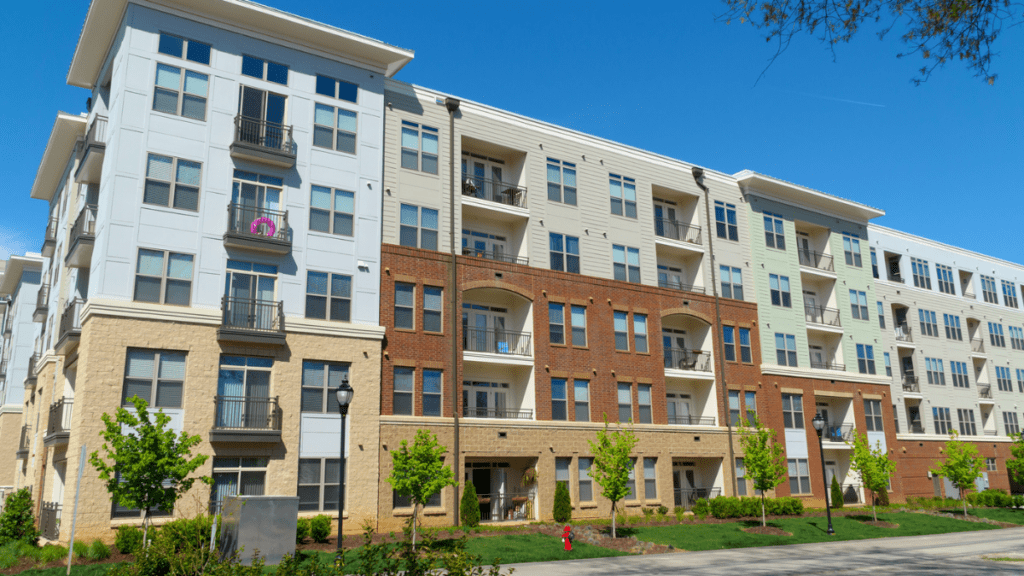Lsat Updated: February 2024

Affordable housing rental properties have become increasingly important as the cost of living continues to rise. These types of rental properties cater to low-income individuals and families who may struggle to find housing within their budget. Many government and private programs have been developed to ensure everyone has access to suitable housing without placing an undue financial burden on them.
What is Affordable Housing?
Affordable Housing Definition
Affordable housing refers to housing units where rental payments account for no more than 30% of a household’s income. In the United States, the Department of Housing and Urban Development (HUD) sets income limits that determine eligibility for affordable housing assistance. These income limits are based on median family incomes and fair market rents. The term covers multiple government subsidized programs aimed at helping low-income families, senior citizens, and individuals with disabilities.
Affordable Housing Explained
The main goal of affordable housing is to ensure that individuals and families have sufficient funds left after paying rent or mortgage to cover other essential expenses such as food, healthcare, and transportation. Affordable housing can vary by region due to differences in local cost of living and median incomes. One of the most popular programs provided by the U.S. Department of Housing and Urban Development (HUD) is the Section 8 Housing Choice Voucher program, which offers rental assistance to financially eligible households. The program defines a rental or mortgage payment as affordable if it accounts for no more than 30 percent of a household’s income.
Types of Affordable Housing
Public vs Subsidized Housing
Among the many types of affordable housing programs, most can be broken down into either public housing and subsidized housing:
Public Housing
Administered by the U.S. Department of Housing and Urban Development (HUD), public housing provides rental properties that are owned and managed by local housing authorities. Eligibility for public housing depends on factors such as income, family size, and citizenship status.
Subsidized Housing
Also overseen by HUD, subsidized housing programs offer financial assistance to eligible renters and homebuyers. These programs may include rent vouchers, tax credits, and direct subsidies. Some examples of subsidized housing programs include the Section 8 Section 8 Housing Choice Voucher and Low-Income Housing Tax Credit (LIHTC).
Different Models of Affordable Housing
Public Housing
Public housing is a government-funded program designed to provide affordable rental housing for low-income families, elderly individuals, and people with disabilities. The properties are usually owned and managed by local public housing agencies.
Section 8
The Section 8 program, also known as the Housing Choice Voucher Program, is a federal rental assistance program that provides rental subsidies to eligible low-income households. The subsidies are provided directly to landlords on behalf of the tenants, allowing the tenants to pay a reduced amount of rent.
Multifamily
Multifamily housing units are properties that contain multiple residential areas, such as apartment buildings and condominiums. In some cases, private developers receive tax credits and financing incentives in exchange for offering a portion of the units at reduced rents for low-income households.
Non-Profit
Non-profit affordable housing providers are organizations that own, develop, and manage housing projects for low-income families, seniors, and people with disabilities. These may include supportive housing programs, which offer services designed to help residents maintain their housing and improve their quality of life.
Housing Choice Voucher Program
The Housing Choice Voucher Program is a federal program that helps low-income families, the elderly, and people with disabilities afford decent, safe, and sanitary housing in the private market. Under this program, participants choose their own housing units, and the vouchers are used to cover a portion of the rent. The program sets limits on the maximum rent that can be charged based on local rental market conditions and the size of the unit. Landlords who participate in the program must follow specific rules and regulations, including maintaining the housing unit to meet the program’s housing quality standards. The rental assistance is paid directly to the landlord on the tenant’s behalf, with the tenant paying the difference between the actual rent and the subsidy provided.
Affordable Housing Regulations
Zoning Laws and Land Use Regulations
Zoning laws and land use regulations play an important role in shaping the affordable rental housing market. These rules determine where and how housing units can be built and may limit the density of residential developments. Some areas have adopted inclusionary zoning policies to require or incentivize developers to build a certain percentage of affordable rental units in new projects. In contrast, other areas may have more restrictive zoning laws, which may unintentionally create barriers to the development of affordable housing rental properties.
Tax Credits and Incentives for Affordable Housing Development
To stimulate the development of affordable rental properties, several tax credits and incentives are available for developers and property owners. One of the most significant programs is the Low-Income Housing Tax Credit (LIHTC) program, which provides funding to developers to build and maintain affordable rental properties for lower-income households. In addition to the LIHTC, there are also state and local programs that provide funding or tax incentives to support the development of affordable rental housing.
Pros and Cons of Affordable Housing
Pros of Affordable Housing:
- Economic stability: Affordable rental housing can contribute to economic stability by enabling low- and moderate-income families to access stable, quality housing.
- Community diversity: Ensuring the availability of affordable rental properties in diverse neighborhoods can promote social and economic integration.
- Reduced homelessness: Affordable rental housing options can help decrease the risk of homelessness for vulnerable populations, relieving pressure on shelters and social services.
Cons of Affordable Housing:
- Limited resources: Funding for affordable housing programs often has limited resources and may be subject to changes in political priorities.
- Not-in-my-backyard (NIMBY) sentiment: Some community members may oppose the development of affordable rental housing in their neighborhoods, potentially leading to legal and regulatory hurdles.
- Quality and maintenance concerns: Affordable rental properties may face challenges related to the quality of construction, and ongoing maintenance may be an issue if inadequate funding is allocated to upkeep.
Financing Affordable Housing Projects
Overview of Funding Sources
The financing of affordable housing projects relies on a combination of funding sources, including government grants, loans, and tax credits. Government grants are typically allocated by federal or local authorities to support affordable housing development. Examples of federal programs include the National Housing Trust Fund (HTF) and the HOME Investment Partnerships Program (HOME). In addition, the Low-Income Housing Tax Credit (LIHTC) is a popular resource for incentivizing private investment in affordable rental properties.
- Grants: Funds that do not need to be repaid, allocated by government agencies or foundations for specific purposes
- Loans: Funds borrowed by the developer at a fixed or variable interest rate, often with more extended repayment terms or favorable conditions
- Tax Credits: Financial incentives that offset tax liabilities, reducing the cost of investment and encouraging more private sector involvement
Public-Private Partnership (PPP) Models
Public-private partnerships (PPPs) are increasingly being used to develop affordable housing projects. A PPP is a collaborative approach that combines the resources and expertise of both the public sector and private enterprises. This can help ensure that the development is financially viable and sustainable in the long run. There are different PPP models, including:
- Build-Operate-Transfer (BOT): where the private sector designs, constructs, and manages the development for a specified period, transferring ownership to the public sector once the contract expires
- Joint Ventures (JV): partnerships where both public and private entities contribute resources, and share the risks and benefits of the project
Financial Viability and Return on Investment Analysis
A critical aspect of affordable housing projects is assessing their financial viability and potential Return on Investment (ROI). This evaluation includes defining project costs, estimating revenue streams, and projecting long-term profitability. Developers must ensure that rental income and operating income are sufficient to cover expenses, including mortgage obligations and ongoing maintenance. Analyzing potential ROI will help identify any risks and challenges, allowing stakeholders to make informed decisions regarding project feasibility. Key components of financial viability analysis include:
- Project Costs: land acquisition, design, permitting, construction, and marketing expenses
- Revenue Streams: rental payments, ancillary income, tax breaks, subsidies, or grants
- ROI: calculation of net profit, allowing investors to assess the potential return compared to alternative investment opportunities
Affordable Housing Property Management
Tenant Selection and Eligibility Verification
An important aspect of managing affordable housing rental properties is tenant selection and eligibility verification. Ensuring that potential tenants qualify for affordable housing is essential in maintaining the property’s compliance with local and federal regulations. Property managers should develop a systematic process for screening applicants, which may include:
- Verifying income and employment status
- Conducting credit and background checks
- Checking rental history and obtaining references
Maintenance and Upkeep
To ensure proper management of affordable housing properties, property managers must focus on maintenance and upkeep strategies. Implementing these strategies enables properties to provide safe and comfortable living conditions for residents. Some key strategies include:
- Regular property inspections
- Timely repair and maintenance
- Implementing energy-efficient and eco-friendly practices
The #1 Rental Property Newsletter
Once a month, we send out an exclusive Rental Property Market Update with top stories, current mortgage rates, building products, and more. No spam and unsubscribe anytime.


Affordable Housing Market Trends
History and Evolution
The affordable housing rental market has undergone several changes over the years. Post-Great Recession, the demand for affordable rental housing surged as many Americans faced financial constraints. Since then, the market has been evolving to address the needs of different communities seeking affordable rental options. The federal government and local municipalities introduced various policies and funding initiatives in response to the crisis, such as tax credits, vouchers, and affordable housing construction. Despite efforts, the supply of affordable housing remained staggeringly low, highlighting the need for continued action.
Affordable Housing Emerging Trends
In recent years, rental prices have seen a significant increase. In 2021, rents rebounded, surging 17.8% during the year and leveling off in the second half of 2022, with prices 22% higher than at the start of the pandemic. This rise has exacerbated the affordable housing crisis, with the U.S. needing an estimated four to five million more homes on the market to meet the growing demand. Emerging trends shaping the future of affordable housing include:
- Innovative Construction Methods: Prefabricated and modular housing options offer potential cost savings, which can translate to more affordable rental properties.
- Public-Private Partnerships: Collaborative efforts between governments and developers can facilitate affordable housing projects, allowing resources and expertise sharing.
- Embrace of Technology: Smart-home technologies, energy-efficient systems, and sustainable building materials can lower operational costs for property owners, helping maintain affordability for renters.
Search Rental Real Estate
Try searching out site for hundreds of rental property topics ranging from property management, investor tool reviews, investment research, and more.
Affordable Housing FAQ
What Are the Eligibility Criteria for Tenants in Affordable Housing?
The eligibility criteria for tenants in affordable housing mainly focus on household income, which generally should not exceed a specific percentage of the Area Median Income (AMI). Other factors taken into consideration include household size, citizenship or eligible noncitizen status, and sometimes the applicants’ rental history or criminal background. The exact criteria may vary depending on the housing program, so it is essential to verify the requirements with the specific affordable housing property or program.
How Are Landlords Compensated for Affordable Housing?
Landlords participating in affordable housing programs receive financial incentives that make it viable to offer below-market rents. These incentives may include tax credits, subsidies, or low-interest loans to develop or maintain affordable rental units. For some rental assistance programs, such as the Section 8 Housing Choice Voucher, landlords receive direct payments from the local housing authority to cover a portion of the rent, while the tenant pays the remaining balance.
Are There Special Tenant Protections With Affordable Tenant Protections?
Tenants living in affordable housing properties have similar legal protections as those in market-rate housing in terms of eviction, rent increases, or lease termination. However, some affordable housing programs may offer additional protections for tenants, such as rent stabilization, grievance procedures, or mediation services, in case of disputes between tenants and landlords. It is important to check the specific program’s regulations or consult with a knowledgeable professional for a better understanding of the tenant protections provided by a particular affordable housing program.
Do Landlords Need to Follow Special Rules and Regulations With Affordable Housing?
Yes, landlords who participate in affordable housing programs are required to follow specific rules and regulations. These requirements may include property maintenance, tenant selection criteria, annual inspections, and rent restrictions. Failure to comply with these rules could result in penalties, reduced financial incentives, or termination from the affordable housing program. It is important for landlords to familiarize themselves with the guidelines of the particular program they participate in and ensure full compliance to maintain their eligibility.
About the Author


Ryan Nelson
I’m an investor, real estate developer, and property manager with hands-on experience in all types of real estate from single family homes up to hundreds of thousands of square feet of commercial real estate. RentalRealEstate is my mission to create the ultimate real estate investor platform for expert resources, reviews and tools. Learn more about my story.
Disclaimer: The information provided on this website does not, and is not intended to, constitute financial or legal advice. As such, all information, content, and materials available on this site are for general informational purposes only. Please review our Editorial Standards for more info.
